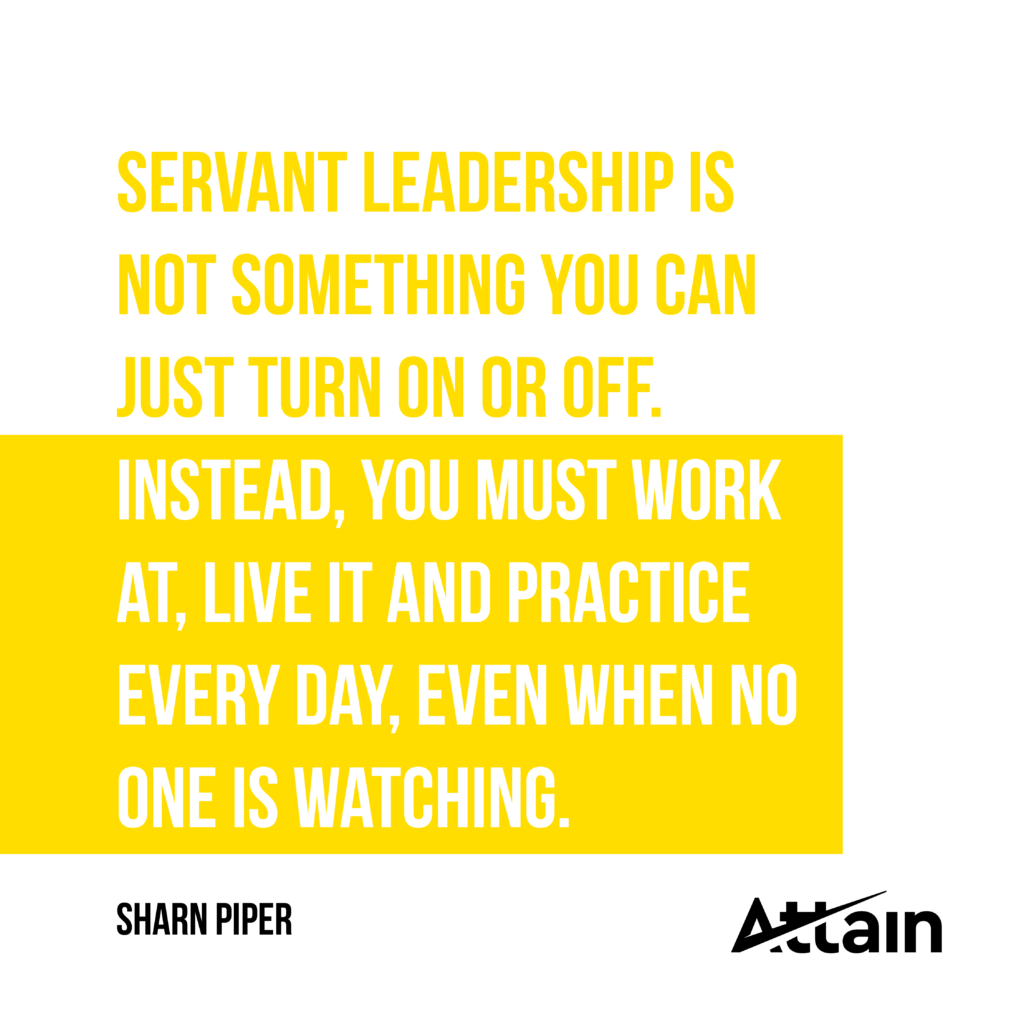How to Be a Servant Leader
While people tend to gravitate towards a particular leadership style, with practice, you can be any type of leader you want.
I’m not naturally a servant leader, but I realised that this style was the one that was going to be the most effective for me to lead teams, create an incredible culture, and achieve amazing things.
One of the first times I saw this in action was when I had to build my first house without anyone instructing me.
I was 17 years old and standing in the middle of the empty section. My colleague was with me and, after a while, he turned to me and said, “where do we start?”
I had no idea.
Every leadership style would have handled this moment differently – with different results.
For me, I knew I couldn’t build the house on my own, I needed my colleague’s help, and it was going to be a tough job.
Instead of thinking about the project from my point of view and sending him off with a list of tasks, I focused on what I could to do to make his job successful. How could I serve him?
If he feels supported and that we’re in this together, he’s going to be happy and engaged in the project. Ultimately, resulting in a beautiful, finished house within the timeframe that had been agreed with our clients.
And it worked – paving the way to grow my construction company into a multi-million dollar business.
Servant leadership works. So, how do you become a servant leader?

Table of Contents
The Ten Characteristics of Servant Leadership
While servant leadership has been around for centuries, it wasn’t until the 1970’s that the phrase “servant leadership” was coined by Robert K. Greenleaf, and this leadership style was studied in-depth.
Based on this research, Larry C. Spears, former president of the Robert K. Greenleaf Center for Servant Leadership, came up with ten of the most important characteristics that servant leaders have.
Listening
Servant leaders listen to everyone in their team – both what is and isn’t being said.
Empathy
They seek to understand the issues and points of view of their staff.
Healing
This covers supporting your people, mentally and physically. Servant leaders make sure their team has the resources, support, knowledge and healthy work environment they need to be successful.
Self-Awareness
Being able to look at yourself, your strengths, weaknesses and values, and see how they affect your team and who else is around you, is essential to leading and serving your team.
Persuasion
This isn’t a bad word in the context of servant leadership. Servant leaders use persuasion, instead of authority, to get members of their team to take action. A key part of this is building a consensus so that everyone is behind and supportive of decisions.
Conceptualisation
Having a big vision and mission is critical to inspire and lead your team.
Foresight
Learning from the past, understanding what is happening in the present, and using these to predict the future is a crucial skill. This includes trusting your gut!
Stewardship
As a servant leader, you’re responsible and accountable for your team, their individual roles and how they perform. You must lead by example.
Commitment to the Growth of People
For servant leaders, one of their biggest goals is the growth of their team and the individuals around them – both personally and professionally.
Building Community
This goes beyond your team, and beyond the goals you’re collectively working towards. Servant leaders are focused on creating a culture and sense of community where everyone feels like they belong.
Servant Leadership in Action
When I was leading a charity, I had an idea that I really wanted to succeed – to hold an event for 2,000 children.
Starting by conceptualising my vision, I had to work out how to make this happen.
Using foresight and having listened to my team when we discussed similar initiatives, I knew that if I pitched the idea to my team straight away, they’d say no. This wasn’t because they didn’t want to help so many children but, due to their past experiences, they would have seen the event as a logistical nightmare – which I could empathise with!
However, I knew it could work, and I knew how we could do it.
Even though I was the leader, I had the self-awareness to know that I couldn’t just tell them this is what we were doing (even though I wanted to!). I needed their support and passion behind the project if we were going to pull it off – it was going to take a community. Therefore, I had to persuade them in a different way.
So, I sowed seeds with different people. Mentioning things here and there of how we could do it, watering and fertilising these seeds until they germinated and grew into ideas. Not my ideas anymore, but theirs.
When the idea of an event for 2,000 children was raised at one of our meetings, I asked, “how can we do this?”
Instead of getting reasons why we couldn’t, I was flooded with ideas of how we could.
They were originally my ideas, but I let them take the credit for it because achieving our now shared vision of holding the event and impacting the lives of so many children was much more important than my ego.
And, as I was committed to their growth, I supported them and their thoughts of how we could make the event a reality.
With this support, the resources they needed (characteristic of healing), and my stewardship as a servant leader, we made happen something we’d never done (or properly considered) before. Together, as a community.

Servant Leadership is More Than a Technique
To Robert K. Greenleaf, servant leadership is not a leadership type or style but a lifestyle.
It’s not merely a hat you put on when you go to work, but a way of living your life.
Unsurprisingly, then, it is not a skill you can do all at once. It takes time and practice to start embodying the characteristics of servant leadership.
To me, this starts with leaving your ego at the door.
We all have an ego and a desire for our contributions and achievements to be recognised.
However, your ego will get in the way of serving your people.
Instead, let others take the credit and have recognition for the success of your team.
And, then you need to be an example for everyone to follow. You can’t do as I say and not as I do. Even when no one is looking, you should be practising the characteristics of servant leadership.

Conclusion
Becoming a servant leader takes time and effort.
It is not something you can just turn on or off. Instead, you must work at, live it and practice it every day, even when no one is watching.
And, the ten characteristics of a servant leader are a great place to start.
While it may seem a lot, the results are worth it and will help you and your team achieve things you never thought possible.
Next month we’re going to look at one of the greatest benefits of servant leadership – culture.

Sharn Piper – CEO
M: +64 27 733 4333
E: sharn@weareattain.com
Having successfully led numerous sales teams, built multiple successful businesses I know what it takes to create a sales process that is robust, repeatable and produces consistent results when applied in a consistent way.

